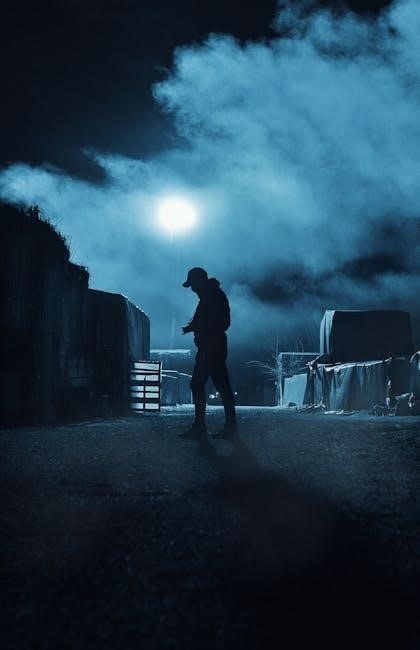Mark Twain’s “A Ghost Story”: An Exploration
Mark Twain’s “A Ghost Story” is available in various PDF formats online. It is a satirical take on the horror genre. The story can be freely downloaded from websites like HauntedBay.com.
Overview of “A Ghost Story”
Mark Twain’s “A Ghost Story” is a short story that blends humor and horror‚ showcasing Twain’s satirical writing style. The narrative revolves around a man who rents a room in an old building‚ only to encounter a ghost with a peculiar identity crisis. This tale is a prime example of Twain’s ability to mock conventional literary genres while entertaining readers. The story is readily available in PDF format online‚ making it easily accessible. It has been adapted and analyzed in various educational settings.
“A Ghost Story” serves as an accessible entry point into Twain’s broader literary works‚ highlighting his wit and social commentary. The story’s availability in PDF form underscores its enduring popularity and relevance in contemporary literary studies. Readers can easily find and enjoy this classic tale. The story involves a ghost with an identity crisis.
Availability of “A Ghost Story” in PDF Format
Mark Twain’s “A Ghost Story” can be easily accessed in PDF format from numerous online sources‚ making it readily available to readers worldwide. Websites like HauntedBay.com offer free downloads of the story‚ ensuring its accessibility for both casual readers and academic researchers. The digital availability of “A Ghost Story” in PDF form allows for convenient reading on various devices‚ including computers‚ tablets‚ and smartphones. This ease of access contributes to the story’s continued popularity.
The widespread distribution of “A Ghost Story” as a PDF facilitates its use in educational settings. Teachers and students can easily share and analyze the text‚ fostering a deeper understanding of Twain’s literary techniques. The story’s presence in digital libraries and online archives further ensures its preservation and accessibility for future generations. The digital format allows readers to enjoy this classic tale.

Plot Summary
The story follows a narrator who rents a room in an old building and encounters a ghost. The ghost suffers from an identity crisis‚ leading to humorous situations.
The Narrator’s Experience in the Old Building
The narrator‚ seeking affordable lodging‚ takes a room in a largely unoccupied‚ old building on Broadway. He initially dismisses tales of ghostly hauntings. The building’s desolate atmosphere contributes to a sense of unease‚ despite his skepticism. The narrator details his initial comfort‚ quickly disrupted by strange occurrences within the seemingly empty structure. He recounts unsettling sounds‚ like bedclothes slipping‚ and an overall eerie stillness broken only by his heart beating loudly.
His experience is marked by a growing sense of superstitious dread. These events lead him to question his initial disbelief. The narrator is trying to rationalize what is happening. He tries to convince himself it is just a dream‚ a “hideous dream”. This shows his initial resistance to accepting the supernatural. The atmosphere of the old building amplifies the strangeness of the events. It pushes the narrator from skepticism to a state of frightened uncertainty.
The Ghost’s Identity Crisis
In Twain’s “A Ghost Story‚” the ghost suffers from a profound identity crisis‚ unsure of its own origins. The ghost’s confusion becomes a source of humor. He struggles to remember the details of his haunting career. This uncertainty undermines the traditional image of a confident and terrifying specter. The ghost even loses his ability to scare people effectively. He is a shadow of his former self‚ lost in a sea of forgotten identities and purposes.
This crisis is further complicated by his inability to perform standard ghostly duties. He forgets his lines and loses his touch for frightening people. The ghost’s memory loss and existential questioning turn the horror trope on its head‚ creating a comedic situation. Instead of inspiring fear‚ the ghost evokes sympathy and amusement. His identity crisis becomes a central element of Twain’s satire on the ghost story genre.

Themes and Satire
“A Ghost Story” employs satire to mock traditional horror tropes. The story explores themes of identity and perception. Twain uses humor to undermine the seriousness of the ghost story genre.
Satire of the Horror Genre
Mark Twain’s “A Ghost Story” masterfully employs satire to dismantle the conventions of the traditional horror genre. Instead of building suspense and fear‚ Twain subverts expectations by injecting humor and absurdity into the narrative. This satirical approach is evident in the ghost’s identity crisis. The ghost’s confusion about its own history and purpose mocks the typical portrayal of ghosts as vengeful or tormented spirits.
The story challenges the reader’s preconceived notions of what a ghost story should be. Twain also uses the narrator’s reactions to further satirize the genre. His initial fear gradually transforms into amusement and even pity for the ghost‚ highlighting the ridiculousness of the situation. The contrast between the narrator’s expected terror and his eventual indifference underscores Twain’s satirical intent.
The story’s comedic elements serve to deflate the horror genre’s self-importance‚ making it a target of lighthearted ridicule. This satirical lens allows Twain to critique the genre’s reliance on clichés and predictable tropes.
The Contrast Between Fear and Amusement
In Mark Twain’s “A Ghost Story‚” a striking contrast emerges between the initial feelings of fear and the subsequent amusement that pervades the narrative. The narrator’s experience begins with a superstitious dread‚ typical of traditional ghost stories. The atmosphere of the old building‚ with its deserted upper stories‚ contributes to a sense of unease and anticipation of something sinister.
However‚ as the story progresses‚ the tone shifts dramatically. The narrator’s fear gradually gives way to amusement as the ghost’s character and plight are revealed. The ghost’s identity crisis and its struggles with its own ghostly existence become sources of humor rather than terror. The narrator‚ initially frightened‚ finds himself pitying the ghost.
This transition from fear to amusement is central to Twain’s satirical approach. By juxtaposing these contrasting emotions‚ Twain undermines the conventions of the horror genre. The story invites readers to laugh at the absurdity of the situation‚ ultimately diminishing the power of fear and highlighting the comedic potential of the supernatural.

Literary Devices
Mark Twain employs several literary devices in “A Ghost Story” to create humor and satire. These include irony‚ hyperbole‚ and understatement‚ all contributing to the story’s comedic effect and critique of the horror genre.
Twain’s Use of Humor
Mark Twain masterfully uses humor in “A Ghost Story” to subvert the traditional horror narrative. The story’s comedic effect stems from several techniques‚ including irony and satire. Twain employs ironic situations‚ such as the ghost’s identity crisis‚ to mock the seriousness often associated with ghost stories. His playful language and exaggerated descriptions further enhance the humorous tone‚ creating a lighthearted atmosphere despite the potentially frightening subject matter.
The story’s humor also arises from its characters’ reactions to the supernatural. The narrator’s shifting perspective‚ from fear to amusement‚ is a key source of comedic relief. Twain’s witty dialogue and absurd scenarios contribute to the overall comedic effect‚ making “A Ghost Story” a memorable and enjoyable read. The humor undermines the typical horror tropes.
The Narrator’s Shifting Perspective
In “A Ghost Story‚” the narrator’s perspective undergoes a significant transformation‚ contributing to the story’s humor and satirical nature. Initially‚ the narrator experiences superstitious dread‚ influenced by the eerie atmosphere of the old building. As the story progresses‚ however‚ his fear gradually gives way to amusement and skepticism. This shift is evident in his changing reactions to the ghost’s antics.
The narrator’s evolving perspective is crucial in highlighting Twain’s satire of the horror genre. Instead of succumbing to terror‚ the narrator begins to find the ghost’s attempts at haunting ridiculous. This transition from fear to amusement allows Twain to mock the conventions of traditional ghost stories. The narrator’s changing viewpoint serves as a vehicle for Twain’s comedic commentary on the supernatural. The narrator’s amusement undermines the seriousness of the situation.

Related Works and Adaptations
“A Ghost Story” shares thematic similarities with other ghost stories. Oscar Wilde’s “The Canterville Ghost” offers a point of comparison. Adaptations of Twain’s work exist in various formats.
Connections to Other Ghost Stories
Mark Twain’s “A Ghost Story” can be contextualized within the broader tradition of ghost stories‚ sharing elements with numerous tales of the supernatural. While Twain employs satire and humor‚ common tropes of the genre‚ like eerie settings and encounters with apparitions‚ are present. The story’s exploration of fear and the uncanny connects it to classic ghost stories that aim to evoke suspense and unease in the reader.
Furthermore‚ “A Ghost Story” can be compared to stories that play with the reader’s expectations‚ subverting traditional horror conventions for comedic effect. Other works explore themes of identity and the afterlife‚ mirroring the ghost’s identity crisis in Twain’s narrative. The story’s availability in PDF format allows modern readers to easily access and compare it to other tales;
Ultimately‚ “A Ghost Story” contributes to the diverse and evolving landscape of ghost stories‚ demonstrating how authors can utilize familiar elements to create unique and thought-provoking narratives.
The Canterville Ghost
Oscar Wilde’s “The Canterville Ghost” offers an interesting point of comparison to Mark Twain’s “A Ghost Story”. Both narratives explore encounters between humans and ghostly figures‚ but their approaches differ significantly. “The Canterville Ghost” blends comedic elements with a touch of sentimentality. It tells the story of an American family who moves into a haunted English manor‚ and their interactions with the resident ghost.
The Canterville ghost‚ unlike the one in Twain’s story‚ seeks to instill fear‚ but is ultimately unsuccessful due to the family’s pragmatic and unfazed nature. Like “A Ghost Story‚” “The Canterville Ghost” subverts traditional ghost story tropes‚ using humor to explore cultural differences and societal expectations. Both stories can be found in PDF format online. This accessibility allows readers to analyze their themes and stylistic choices side-by-side‚ appreciating the unique contributions of Twain and Wilde to the genre.


